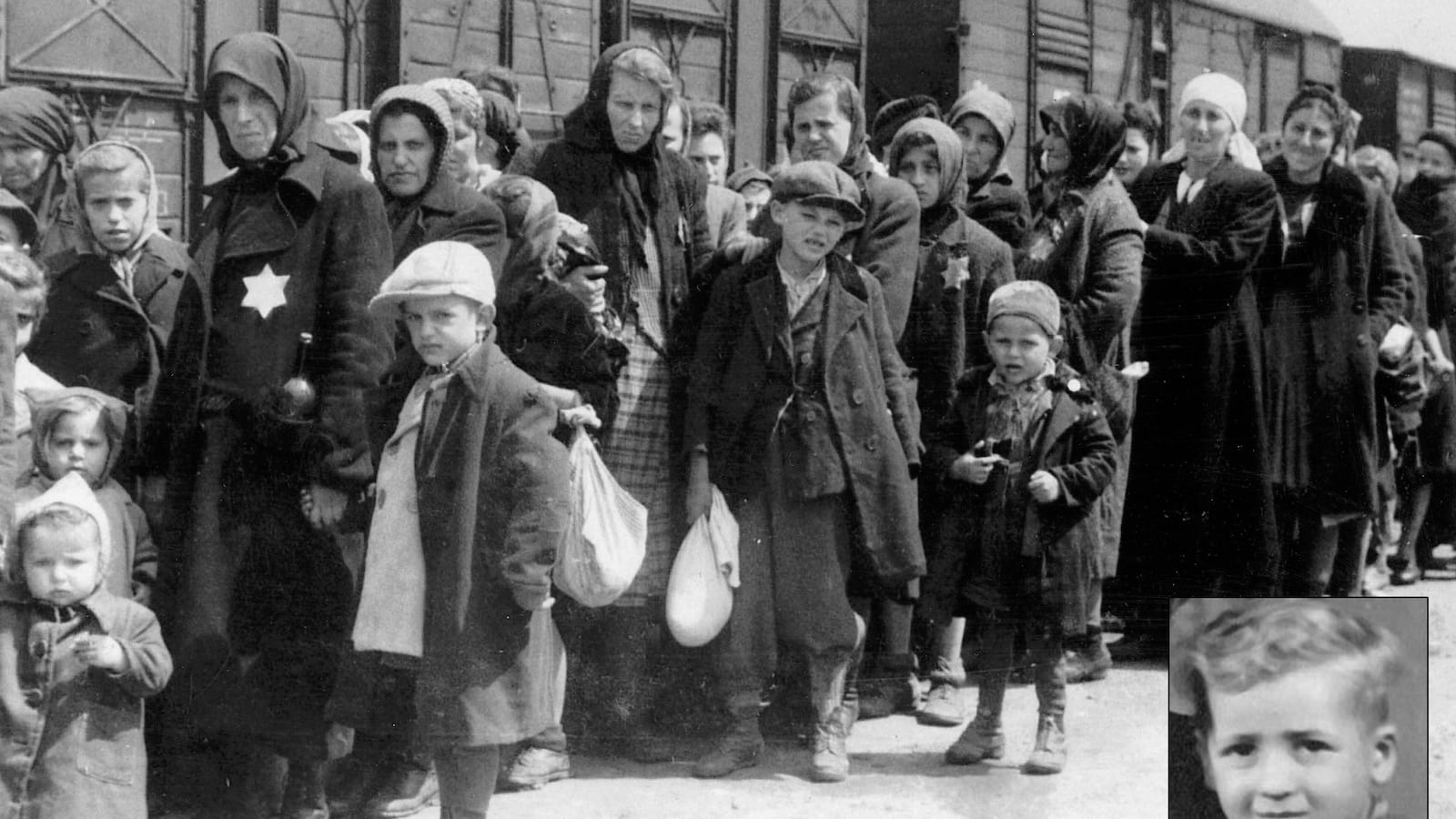It’s most likely that Menachem Bodner last saw his identical twin in 1945, in Dr. Josef Mengele’s gruesome Auschwitz laboratory. He was 4 then and doesn’t remember his time in the notorious death camp. But in the 68 years that have followed, Bodner says he’s “always” been certain he was one of a pair. He just didn’t have any proof until this past year. Now, he’s searching for Jeno, a man who probably looks just like him, and who has a distinctive “A-7734” tattoo on his forearm. And 1 million Facebook users are helping him look.

Mengele, known among prisoners as “the Angel of Death,” was deeply fascinated with twins and used them for research experiments in his macabre Auschwitz lab. Thankfully, Bodner, now 72, has no recollection of the cruelty he most certainly endured while undergoing experiments, though he can remember a sense of paralyzing fear. Unfortunately he also has few impressions of his family’s prewar life in a small town east of Munkacs, Hungary, which is now in the Ukraine. But despite the lack of memories from a war-marred childhood, Bodner says that throughout his life he’s felt a deep connection with his twin—and is positive he’s still alive and out there. But where?
Until last May, Bodner didn’t even know that his own name was once Elias Gottesmann. Now he knows that. And he knows for certain that he has a twin—thanks to the Nazis’ dogged, pathological documentation of their crimes. Ayana KimRon, a professional genealogist in Israel, found the evidence, clearly written in a record put together by the organization Candles, of twins who were “identified as having been liberated at Auschwitz or from a subcamp”:
A-7733, Gottesmann, Elias, 4A-7734, Gottesmann, Jeno, 4
KimRon got onto the case after spotting a posting made on a genealogical forum by a cousin of Bodner’s partner, seeking information about the long-missing brother. When the woman was unable to answer KimRon’s questions, Bodner ended up calling the curious researcher himself. “I was hooked,” KimRon says of that first call. “I said, ‘Look I’m going all the way with you,’ and it turned out to be the project of my life.” Bodner, a retired Israeli tax-service employee living in the Tel Aviv suburb of Rishon LeZion, was dubious at first, but KimRon began digging anyway. She asked him if he had any sense of his brother, and he told her, “All my life I’ve known that he was alive somewhere; I felt that he was alive.”
In early March, after months of dead-end trails and fruitless posts within the Jewish and genealogical communities online, KimRon decided the campaign needed a broader audience. She created a Facebook page titled “A7734,” posted a black-and-white shot of a young boy and a caption with his tattoo number, and asked for any clues into his whereabouts. Within 24 hours it had gone viral, and a within a week, the photo has had 23,000 shares, 1.13 million views, and hundreds of comments from readers offering resources, prayers, and words of encouragement. Other twins pledged to help. Amateur etymologists traced their names. One man even attempted to age the photo into what Jeno (known by his nickname Jolli) might look like now.

“I was astonished by the amount of comments, and I’m very grateful for each and every one one of them,” Bodner, who speaks Hebrew, says of the rapid response. Before talking to The Daily Beast, he and KimRon had been watching the page, mesmerized as the comments and countries rolled in: China, Argentina, Ireland, Portugal, Finland. The success is galvanizing, and Facebook is just the beginning. “I’m going to maximize the Internet,” KimRon says, explaining that her next plan is to build a YouTube channel of Bodner speaking (a Twitter account launched Sunday night).
In 1945, as allied troops advanced into Poland and the Germans fled Auschwitz—the most notorious of Nazi death camps—a boy approached a young Jewish man searching for his family and asked: “Will you be my father?” When the man asked his name, young Elias Gottesmann took a guess, saying his first name was Mendele and giving a similar-sounding last name. More than a half-century later, he laughs and shrugs when asked how he came up with that new name.
As the pair walked out of the camp a few days later, they saw a battalion of Soviet soldiers approaching. “I don’t like them,” he told the man. “They didn’t save my brother, Jolli.” Five years later, the ramshackle family moved to Israel. When Bodner turned 20, his adoptive parents told him about those words. Despite searching through Jewish agencies and publishing requests, searches using the name Bodner had yielded no clues about the fate of his brother.
But when KimRon ran the unique tattoo number through the Red Cross records, she soon found the proof of the twin Bodner always knew existed. In a hospital record dated February 9, 1945—nearly two weeks after Auschwitz was liberated—his brother’s name shows up. Ironically, as Bodner lived with his adoptive family in a neighboring camp, Jolli was just inside those infamous gates. KimRon explains why Bodner never searched for himself or his brother using the inked numbers on his arm: “That’s the symbol of turning human beings into numbers,” she says. “People don’t want to relate to it.” She utilized it because she realized it was the only way past the dead-end trails.
Patricia Heberer, a historian at the United States Holocaust Memorial Museum in Washington, D.C., and author of Children During the Holocaust, explains that twins studied by Mengele were housed together in barracks, underwent daily physical examination, and received surgeries or experimentations as a pair. “Experimentation included injections that caused pain or disease, spinal taps and spinal injections, and deliberate infection with certain diseases,” she says. Surgeries were even more gruesome.
Because of Mengele’s secretive nature (he “destroyed much of the documentation about his ‘research efforts’ in his effort to avoid capture,” Heberer says), many twin survivors, like Jeno and Elias, have spent the rest of their lives unaware of the nature of their experimentation and suffer serious health consequences as well.
Along with historical records, KimRon found a flock of nearly 70 extended family members both in Israel and the U.S for a man who believed he had no blood relatives. Many of them had searched for Bodner for years. “I was shocked,“ he says. “I thought that nobody would look for me. I had a dream to find someone. It made my dreams come true.” Within less than a year, Bodner has quickly assimilated into his family, and KimRon, who has found herself as part of the clan, says that the relatives “embrace as if they were together since birth.” Bodner speaks to his new cousins weekly, and they’ve spent the past year’s holidays together. “I’m still memorizing the names,” he says with a laugh.
The enigmatic connection between family members who spend years separated is well documented. Nancy Segal, a psychology professor at California State University, Fullerton, and director of the Twin Studies Center, has spent years researching twin connections. She says that even after decades apart, many twins still find they have similar attitudes, values, and interests upon reuniting. “Sometimes circumstances of rearing and living can get in the way,” she wrote in an email. “But even some who met in their sixties and seventies did well together.”
Despite the skepticism he had going in to the search, Bodner has been eager to soak up his newfound history. “This man has quick digestion. He wants to face the demons,” KimRon says reverently. In June—just a month after learning of his family—Bodner traveled to his small hometown in what is now Ukraine, but was once Hungary. When he arrived, an old woman approached the group, looking at the house they were eyeing. She still recalled his family. “In this house there were twins,” she told them. Bodner, too, remembered the house and the Gestapo officers who came to take them from it two months before his fourth birthday. “I remember when Nazis came to take us: it was midday, I was outside, and my brother was asleep in bed,” he says. “I saw them coming.”
This June, Bodner, KimRon and four family members plan to make a trip back to Auschwitz, the death camp that once housed him, his brother, and his mother (a survivor who was murdered a year after the Holocaust while searching for her sons). The last time he was there was just a few weeks after liberation, when a Jewish journalist asked Bodner and his adoptive father to take him. As they approached the gates, the 5-year-old panicked. “I don’t want to go there,” he screamed. “They turn people to dust in there; I don’t want to go there.”
Sixty-eight years later, Bodner is ready to try again. “Until now I didn’t have the mental strength to do it,” he says, “but after finding my family and my house, it is time to close the circle.” As for his twin, he knows he’s out there somewhere. And Facebook’s combined power of 1 billion users is a promising allure to renew optimism. “I never lost hope, and now I hope more,” Bodner says.
UPDATE: Menachem Bodner died in 2015 at the age of 74, two years after beginning his journey to find his twin and reconnecting with his extended family.





